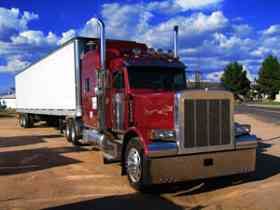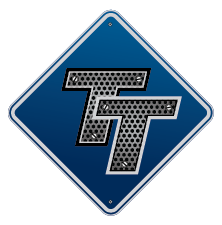Wagging Double 28
Topic 21508 | Page 1
The rear wagon will wiggle the most - that's just good old physics. You have to keep that steering wheel as steady and smooth as possible to help keep that rear trailer from doing the dance. The slightest input on the wheel is exaggerated considerably by your final trailer when pulling doubles or triples.
Doubles:
Refers to pulling two trailers at the same time, otherwise known as "pups" or "pup trailers" because they're only about 28 feet long. However there are some states that allow doubles that are each 48 feet in length.
Was the rear trailer heavier?
Was the rear trailer heavier?
That is one of the main things to keep a wiggle wagon from wiggling. You want the rear trailer to be lighter if at all possible. And as OS said smooth on the steering and braking manuvers.

You might find that going just a little faster or slower may change the wiggle factor. Also make sure tire pressures are as even as possible. And slow smooth steering input is very helpful.

Anytime you’re driving doubles or triples you just drive the truck. The trailers will follow. The more adjustments you try to do with the truck to straighten out the trailers will cause the trailers to wiggle more. As the above posters stated heavier trailer in the front lighter trailer in the rear. Also make sure your congear fifth wheel is greased. A dry congear will make it wiggle more.
Doubles:
Refers to pulling two trailers at the same time, otherwise known as "pups" or "pup trailers" because they're only about 28 feet long. However there are some states that allow doubles that are each 48 feet in length.
When Inwas running a transfer truck its not technically a double but its very similar. I found counting while changing lanes to be very helpful. count 1,2,3... each time your signal “blinks”
practice when noone is around you.
signal, count to 5, then start to merge, take about 5 to 7 seconds to complete the change. being completely in your new lane and turning the signal off between 11-14 seconds.
try to focus on keeping that back trailer off the lines after the change.
practice when noone is around so you dont have to focus on your mirrors in a nervous way.
focusing on that back trailer youre probably trying to correct every tiny twitch you make and its like the domino effect.
when coming up on a long highway turn practice making it as smooth as possible and turning the wheel slowly into that turn if the truck amd turn allows. most turns are supposed to be surveyed as a spiral curve like a trains tracks... starting at 0 degrees. Virginia has good surveyors california... not so good. so it becomes more gradual and then its steady and then it goes back to 0. of course thats not always available but you may have enough room to attempt it within the lines.
practice dofferent things when noone is around you. just do not practice being a snake. it looks really cool but its dangerous.
Watch the trailer and see what it does if you refuse to correct what appears to be a problem. And of course the speed, the lines in the road, and nature play a part as well. Super Singles tend to follow lines or dips for some reason more than duals. If you have duals on the truck and first trailer and super singles on the second trailer...
Theres a lot but really just focus on not correcting what you thinknis a problem. it might be the little trying to be perfect twitch. Feeling like your too close. then your check your other mirrow and you feel too close and then you go back and forth trying to stay away from the line. focus more ahead of you and what the truck is doing... glance the mirrors but dont give that line in your mirror the most attention.
Super Singles:
A single, wide wheel substituted for a tandem (two wheel) assembly. The main benefit of a super single is a reduction in weight and lower rolling resistance which provide better fuel economy. The disadvantage is the lack of tire redundancy (or a 'backup tire' in case of a blowout) from which tandem wheels benefit. A tire blowout is more dangerous with a super single and can not be driven on.
I have never pulled doubles. What everyone else has said is true. As far as keeping straight. Look at the road in front of you, see the fark stripe down the middle of the lane. Keep that line under the big toe of your right foot or your right butt cheek. That will help you stay straight. When changing lanes, look, look, look. Then when all is clear go slow and steady. Turn your wheel just a little. When your first steer tire crosses into the lane you're moving to straighten the wheel and everything will slowly follow you into the lane. With, doubles , tripples and tankers, smooth is the key.
Doubles:
Refers to pulling two trailers at the same time, otherwise known as "pups" or "pup trailers" because they're only about 28 feet long. However there are some states that allow doubles that are each 48 feet in length.
New Reply:
New! Check out our help videos for a better understanding of our forum features

















Preview:








 TT On Facebook
TT On Facebook
Anyone has experienced wagging issue? My first trip pulling a double 28 was from MO to Indy, I have been pulling 53 vans for over a year, but I got a new job line line hauler pulling 2 28 ft long. So what should I do to remain steady on the road, to keep them straight without wagging, and the rear one was the wagging one. Any advise that can help me for my next trip. Thank you. And God bless you all.
Line Haul:
Linehaul drivers will normally run loads from terminal to terminal for LTL (Less than Truckload) companies.
LTL (Less Than Truckload) carriers will have Linehaul drivers and P&D drivers. The P&D drivers will deliver loads locally from the terminal and pick up loads returning them to the terminal. Linehaul drivers will then run truckloads from terminal to terminal.